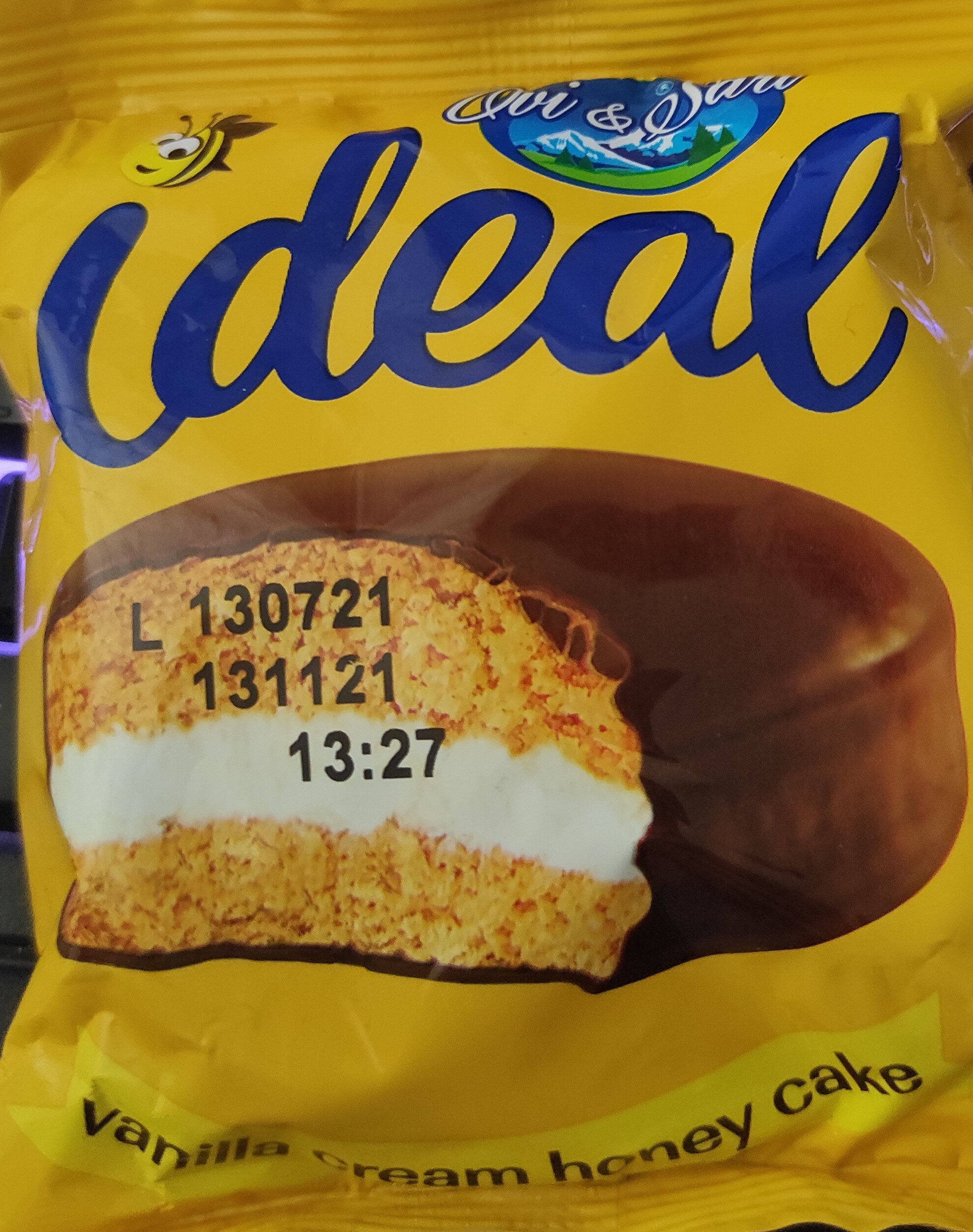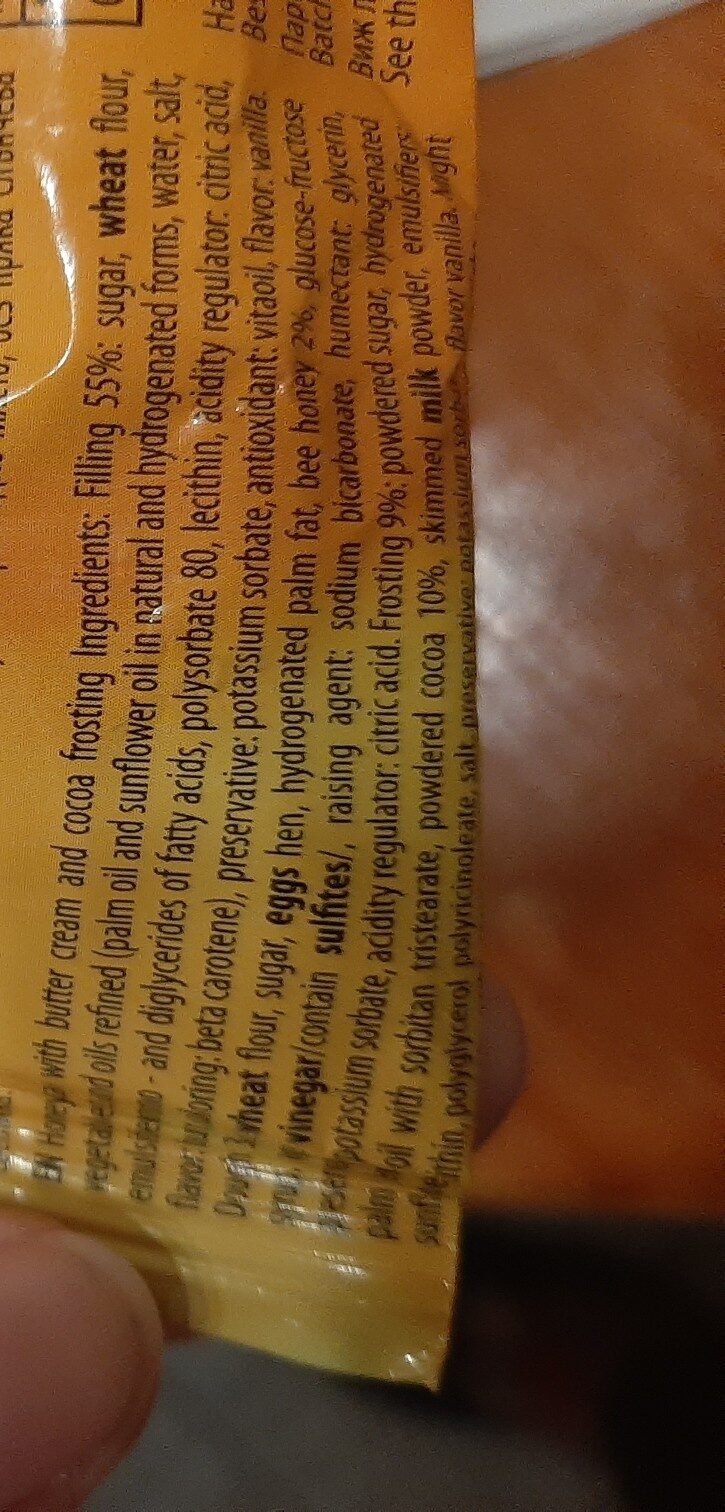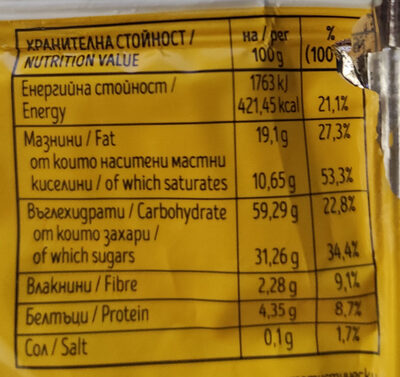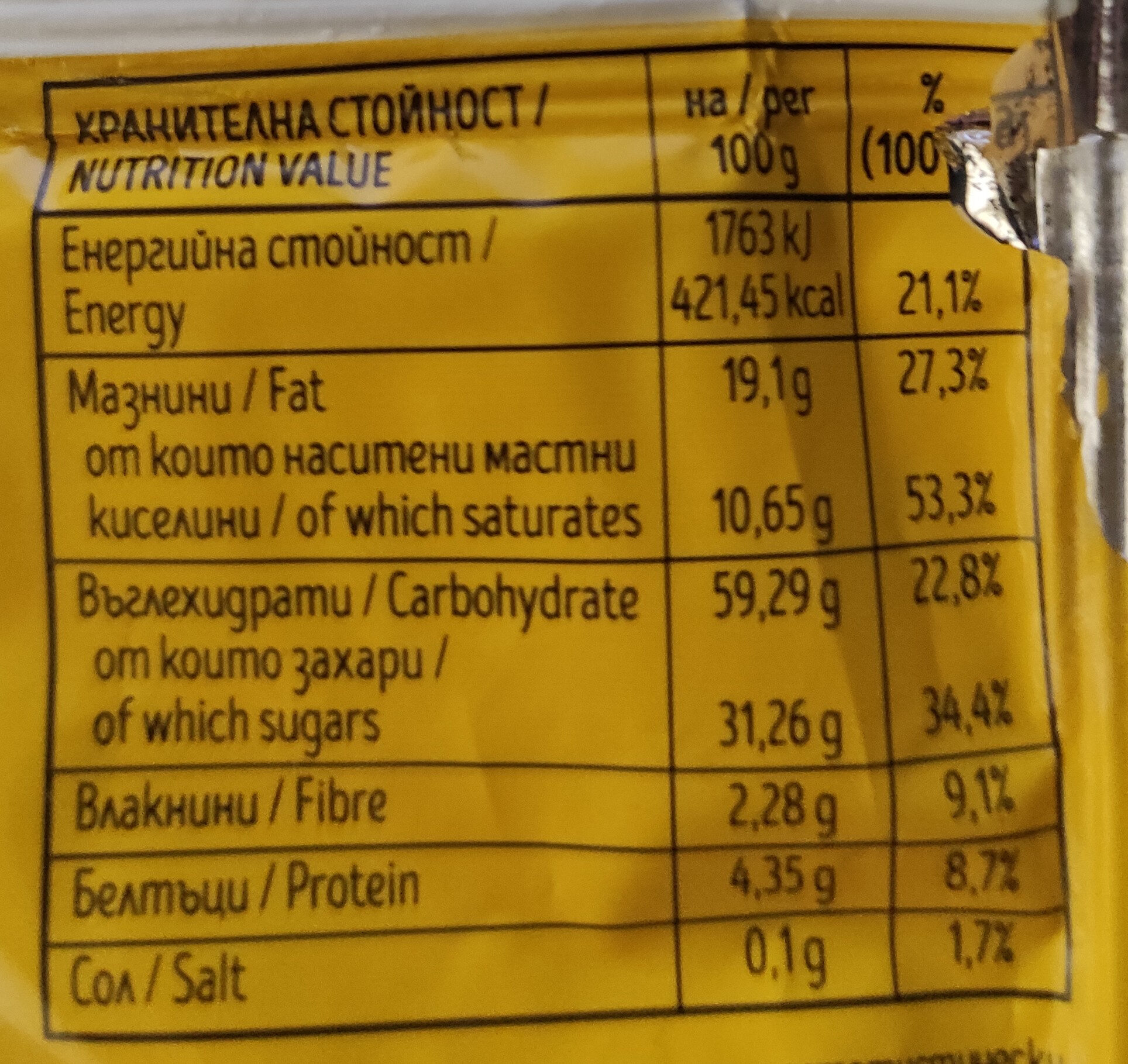Help us make food transparency the norm!
As a non-profit organization, we depend on your donations to continue informing consumers around the world about what they eat.
The food revolution starts with you!
Ideal - Vanilla Cream Honey Cake - Ovi & Sari - 90g
Ideal - Vanilla Cream Honey Cake - Ovi & Sari - 90g
This product page is not complete. You can help to complete it by editing it and adding more data from the photos we have, or by taking more photos using the app for Android or iPhone/iPad. Thank you!
×
Barcode: 3800202841039 (EAN / EAN-13)
Quantity: 90g
Packaging: Plastic
Brands: Ovi & Sari
Categories: Snacks, Desserts, Sweet snacks, Biscuits and cakes, Cakes, Sponge cakes, Sponge cake filled and covered with chocolate
Origin of ingredients: Bulgaria
Manufacturing or processing places: Bulgaria
Countries where sold: Bulgaria
Matching with your preferences
Health
Ingredients
-
42 ingredients
filling 55%: sugar, wheat flour, vegetaled ols refined (palm oil and sunflower oil in natural and hydrogenated forms, water, salt, emulstemo-and diglycerides of fatty acids, polysorbate 80, lecithin, acidity regulator: citric acid, h favor tudoring: beta carotene), preservative: potassium sorbate, antioxidant: vitaoil, flavor: vanilla, dwnheat flour, sugar, eggs hen, hydrogenated palm fat, bee honey 29%, glucose-fructose nag rinegar/contain sulfites/, raising agent: sodium bicarbonate, humectant giycerin, 1botassium sorbate, acidity regulator: citric acid, frosting 9%, powdered sugar, hydrogenated suk pa moil with sorbitan tristearate, powdered cocoa 10%, skimmed milk powder, emulsifiers see th bes batch sontenhin oolyglycerol polyricinoleate, salt,presenatives patassiumsort flavor vanilla, ghtAllergens: Gluten
Food processing
-
Ultra processed foods
Elements that indicate the product is in the 4 - Ultra processed food and drink products group:
- Additive: E160a - Carotene
- Additive: E322 - Lecithins
- Additive: E433 - Polyoxyethylene sorbitan monooleate
- Additive: E492 - Sorbitan tristearate
- Ingredient: Flavouring
Food products are classified into 4 groups according to their degree of processing:
- Unprocessed or minimally processed foods
- Processed culinary ingredients
- Processed foods
- Ultra processed foods
The determination of the group is based on the category of the product and on the ingredients it contains.
Additives
-
E160a - Carotene
Carotene: The term carotene -also carotin, from the Latin carota, "carrot"- is used for many related unsaturated hydrocarbon substances having the formula C40Hx, which are synthesized by plants but in general cannot be made by animals -with the exception of some aphids and spider mites which acquired the synthesizing genes from fungi-. Carotenes are photosynthetic pigments important for photosynthesis. Carotenes contain no oxygen atoms. They absorb ultraviolet, violet, and blue light and scatter orange or red light, and -in low concentrations- yellow light. Carotenes are responsible for the orange colour of the carrot, for which this class of chemicals is named, and for the colours of many other fruits, vegetables and fungi -for example, sweet potatoes, chanterelle and orange cantaloupe melon-. Carotenes are also responsible for the orange -but not all of the yellow- colours in dry foliage. They also -in lower concentrations- impart the yellow coloration to milk-fat and butter. Omnivorous animal species which are relatively poor converters of coloured dietary carotenoids to colourless retinoids have yellowed-coloured body fat, as a result of the carotenoid retention from the vegetable portion of their diet. The typical yellow-coloured fat of humans and chickens is a result of fat storage of carotenes from their diets. Carotenes contribute to photosynthesis by transmitting the light energy they absorb to chlorophyll. They also protect plant tissues by helping to absorb the energy from singlet oxygen, an excited form of the oxygen molecule O2 which is formed during photosynthesis. β-Carotene is composed of two retinyl groups, and is broken down in the mucosa of the human small intestine by β-carotene 15‚15'-monooxygenase to retinal, a form of vitamin A. β-Carotene can be stored in the liver and body fat and converted to retinal as needed, thus making it a form of vitamin A for humans and some other mammals. The carotenes α-carotene and γ-carotene, due to their single retinyl group -β-ionone ring-, also have some vitamin A activity -though less than β-carotene-, as does the xanthophyll carotenoid β-cryptoxanthin. All other carotenoids, including lycopene, have no beta-ring and thus no vitamin A activity -although they may have antioxidant activity and thus biological activity in other ways-. Animal species differ greatly in their ability to convert retinyl -beta-ionone- containing carotenoids to retinals. Carnivores in general are poor converters of dietary ionone-containing carotenoids. Pure carnivores such as ferrets lack β-carotene 15‚15'-monooxygenase and cannot convert any carotenoids to retinals at all -resulting in carotenes not being a form of vitamin A for this species-; while cats can convert a trace of β-carotene to retinol, although the amount is totally insufficient for meeting their daily retinol needs.Source: Wikipedia
-
E160ai - Beta-carotene
Beta-Carotene: β-Carotene is an organic, strongly colored red-orange pigment abundant in plants and fruits. It is a member of the carotenes, which are terpenoids -isoprenoids-, synthesized biochemically from eight isoprene units and thus having 40 carbons. Among the carotenes, β-carotene is distinguished by having beta-rings at both ends of the molecule. β-Carotene is biosynthesized from geranylgeranyl pyrophosphate.β-Carotene is the most common form of carotene in plants. When used as a food coloring, it has the E number E160a. The structure was deduced by Karrer et al. in 1930. In nature, β-carotene is a precursor -inactive form- to vitamin A via the action of beta-carotene 15‚15'-monooxygenase.Isolation of β-carotene from fruits abundant in carotenoids is commonly done using column chromatography. It can also be extracted from the beta-carotene rich algae, Dunaliella salina. The separation of β-carotene from the mixture of other carotenoids is based on the polarity of a compound. β-Carotene is a non-polar compound, so it is separated with a non-polar solvent such as hexane. Being highly conjugated, it is deeply colored, and as a hydrocarbon lacking functional groups, it is very lipophilic.Source: Wikipedia
-
E202 - Potassium sorbate
Potassium sorbate (E202) is a synthetic food preservative commonly used to extend the shelf life of various food products.
It works by inhibiting the growth of molds, yeast, and some bacteria, preventing spoilage. When added to foods, it helps maintain their freshness and quality.
Some studies have shown that when combined with nitrites, potassium sorbate have genotoxic activity in vitro. However, potassium sorbate is generally recognized as safe (GRAS) by regulatory authorities.
-
E322 - Lecithins
Lecithins are natural compounds commonly used in the food industry as emulsifiers and stabilizers.
Extracted from sources like soybeans and eggs, lecithins consist of phospholipids that enhance the mixing of oil and water, ensuring smooth textures in various products like chocolates, dressings, and baked goods.
They do not present any known health risks.
-
E322i - Lecithin
Lecithins are natural compounds commonly used in the food industry as emulsifiers and stabilizers.
Extracted from sources like soybeans and eggs, lecithins consist of phospholipids that enhance the mixing of oil and water, ensuring smooth textures in various products like chocolates, dressings, and baked goods.
They do not present any known health risks.
-
E330 - Citric acid
Citric acid is a natural organic acid found in citrus fruits such as lemons, oranges, and limes.
It is widely used in the food industry as a flavor enhancer, acidulant, and preservative due to its tart and refreshing taste.
Citric acid is safe for consumption when used in moderation and is considered a generally recognized as safe (GRAS) food additive by regulatory agencies worldwide.
-
E433 - Polyoxyethylene sorbitan monooleate
Polysorbate 80: Polysorbate 80 is a nonionic surfactant and emulsifier often used in foods and cosmetics. This synthetic compound is a viscous, water-soluble yellow liquid.Source: Wikipedia
-
E492 - Sorbitan tristearate
Sorbitan tristearate: Sorbitan tristearate is a nonionic surfactant. It is variously used as a dispersing agent, emulsifier, and stabilizer, in food and in aerosol sprays. As a food additive, it has the E number E492. Brand names for polysorbates include Alkest, Canarcel, and Span. The consistency of sorbitan tristearate is waxy; its color is light cream to tan.Source: Wikipedia
-
E500 - Sodium carbonates
Sodium carbonates (E500) are compounds commonly used in food preparation as leavening agents, helping baked goods rise by releasing carbon dioxide when they interact with acids.
Often found in baking soda, they regulate the pH of food, preventing it from becoming too acidic or too alkaline. In the culinary world, sodium carbonates can also enhance the texture and structure of foods, such as noodles, by modifying the gluten network.
Generally recognized as safe, sodium carbonates are non-toxic when consumed in typical amounts found in food.
-
E500ii - Sodium hydrogen carbonate
Sodium hydrogen carbonate, also known as E500ii, is a food additive commonly used as a leavening agent.
When added to recipes, it releases carbon dioxide gas upon exposure to heat or acids, causing dough to rise and resulting in a light, fluffy texture in baked goods.
It is generally recognized as safe (GRAS) by regulatory authorities when used in appropriate quantities and poses no significant health risks when consumed in typical food applications.
-
E570 - Fatty acids
Fatty acid: In chemistry, particularly in biochemistry, a fatty acid is a carboxylic acid with a long aliphatic chain, which is either saturated or unsaturated. Most naturally occurring fatty acids have an unbranched chain of an even number of carbon atoms, from 4 to 28. Fatty acids are usually not found per se in organisms, but instead as three main classes of esters: triglycerides, phospholipids, and cholesterol esters. In any of these forms, fatty acids are both important dietary sources of fuel for animals and they are important structural components for cells.Source: Wikipedia
Ingredients analysis
-
Palm oil
Ingredients that contain palm oil: Hydrogenated palm fat
-
Non-vegan
Non-vegan ingredients: Bee honey, Skimmed milk powderSome ingredients could not be recognized.
We need your help!
You can help us recognize more ingredients and better analyze the list of ingredients for this product and others:
- Edit this product page to correct spelling mistakes in the ingredients list, and/or to remove ingredients in other languages and sentences that are not related to the ingredients.
- Add new entries, synonyms or translations to our multilingual lists of ingredients, ingredient processing methods, and labels.
If you would like to help, join the #ingredients channel on our Slack discussion space and/or learn about ingredients analysis on our wiki. Thank you!
-
Vegetarian status unknown
Unrecognized ingredients: Vegetaled-ols-refined, Palm-oil-and-sunflower-oil-in-natural-and-hydrogenated-forms, Emulstemo-and-diglycerides-of-fatty-acids, H-favor-tudoring, Vitaoil, Dwnheat-flour, Eggs-hen, Glucose-fructose-nag-rinegar, Sulfite, Humectant-giycerin, 1botassium-sorbate, Frosting, Hydrogenated-suk-pa-moil-with-sorbitan-tristearate, Emulsifiers-see-th-bes-batch-sontenhin-oolyglycerol-polyricinoleate, Presenatives-patassiumsort-flavor-vanilla, GhtSome ingredients could not be recognized.
We need your help!
You can help us recognize more ingredients and better analyze the list of ingredients for this product and others:
- Edit this product page to correct spelling mistakes in the ingredients list, and/or to remove ingredients in other languages and sentences that are not related to the ingredients.
- Add new entries, synonyms or translations to our multilingual lists of ingredients, ingredient processing methods, and labels.
If you would like to help, join the #ingredients channel on our Slack discussion space and/or learn about ingredients analysis on our wiki. Thank you!
-
Details of the analysis of the ingredients
We need your help!
Some ingredients could not be recognized.
We need your help!
You can help us recognize more ingredients and better analyze the list of ingredients for this product and others:
- Edit this product page to correct spelling mistakes in the ingredients list, and/or to remove ingredients in other languages and sentences that are not related to the ingredients.
- Add new entries, synonyms or translations to our multilingual lists of ingredients, ingredient processing methods, and labels.
If you would like to help, join the #ingredients channel on our Slack discussion space and/or learn about ingredients analysis on our wiki. Thank you!
: filling 55% (sugar), wheat flour, vegetaled ols refined (palm oil and sunflower oil in natural and hydrogenated forms, water, salt, emulstemo-and diglycerides of fatty acids, polysorbate 80, lecithin, acidity regulator (citric acid), h favor tudoring (beta carotene)), preservative (potassium sorbate), antioxidant (vitaoil), flavor (vanilla), dwnheat flour, sugar, eggs hen, hydrogenated palm fat, bee honey 29%, glucose-fructose nag rinegar, contain sulfites, raising agent (sodium bicarbonate), humectant giycerin, 1botassium sorbate, acidity regulator (citric acid), frosting 9%, powdered sugar, hydrogenated suk pa moil with sorbitan tristearate, cocoa 10%, skimmed milk powder, emulsifiers see th bes batch sontenhin oolyglycerol polyricinoleate, salt, presenatives patassiumsort flavor vanilla, ght- filling -> en:filling - vegan: maybe - vegetarian: maybe - percent: 55
- sugar -> en:sugar - vegan: yes - vegetarian: yes - ciqual_proxy_food_code: 31016
- wheat flour -> en:wheat-flour - vegan: yes - vegetarian: yes - ciqual_proxy_food_code: 9410
- vegetaled ols refined -> en:vegetaled-ols-refined
- palm oil and sunflower oil in natural and hydrogenated forms -> en:palm-oil-and-sunflower-oil-in-natural-and-hydrogenated-forms
- water -> en:water - vegan: yes - vegetarian: yes - ciqual_food_code: 18066
- salt -> en:salt - vegan: yes - vegetarian: yes - ciqual_food_code: 11058
- emulstemo-and diglycerides of fatty acids -> en:emulstemo-and-diglycerides-of-fatty-acids
- polysorbate 80 -> en:e433 - vegan: maybe - vegetarian: maybe - from_palm_oil: maybe
- lecithin -> en:e322i - vegan: maybe - vegetarian: maybe
- acidity regulator -> en:acidity-regulator
- citric acid -> en:e330 - vegan: yes - vegetarian: yes
- h favor tudoring -> en:h-favor-tudoring
- beta carotene -> en:e160ai - vegan: maybe - vegetarian: maybe - from_palm_oil: maybe
- preservative -> en:preservative
- potassium sorbate -> en:e202 - vegan: yes - vegetarian: yes
- antioxidant -> en:antioxidant
- vitaoil -> en:vitaoil
- flavor -> en:flavouring - vegan: maybe - vegetarian: maybe
- vanilla -> en:vanilla - vegan: yes - vegetarian: yes
- dwnheat flour -> en:dwnheat-flour
- sugar -> en:sugar - vegan: yes - vegetarian: yes - ciqual_proxy_food_code: 31016
- eggs hen -> en:eggs-hen
- hydrogenated palm fat -> en:hydrogenated-palm-fat - vegan: yes - vegetarian: yes - from_palm_oil: yes - ciqual_proxy_food_code: 16129
- bee honey -> en:bee-honey - vegan: no - vegetarian: yes - ciqual_food_code: 31008 - percent: 29
- glucose-fructose nag rinegar -> en:glucose-fructose-nag-rinegar
- contain sulfites -> en:sulfite
- raising agent -> en:raising-agent
- sodium bicarbonate -> en:e500ii - vegan: yes - vegetarian: yes
- humectant giycerin -> en:humectant-giycerin
- 1botassium sorbate -> en:1botassium-sorbate
- acidity regulator -> en:acidity-regulator
- citric acid -> en:e330 - vegan: yes - vegetarian: yes
- frosting -> en:frosting - percent: 9
- powdered sugar -> en:icing-sugar - vegan: yes - vegetarian: yes - ciqual_proxy_food_code: 31016
- hydrogenated suk pa moil with sorbitan tristearate -> en:hydrogenated-suk-pa-moil-with-sorbitan-tristearate
- cocoa -> en:cocoa - vegan: yes - vegetarian: yes - ciqual_proxy_food_code: 18100 - percent: 10
- skimmed milk powder -> en:skimmed-milk-powder - vegan: no - vegetarian: yes - ciqual_food_code: 19054
- emulsifiers see th bes batch sontenhin oolyglycerol polyricinoleate -> en:emulsifiers-see-th-bes-batch-sontenhin-oolyglycerol-polyricinoleate
- salt -> en:salt - vegan: yes - vegetarian: yes - ciqual_food_code: 11058
- presenatives patassiumsort flavor vanilla -> en:presenatives-patassiumsort-flavor-vanilla
- ght -> en:ght
Nutrition
-
Missing data to compute the Nutri-Score
Missing nutrition facts
⚠ ️The nutrition facts of the product must be specified in order to compute the Nutri-Score.Could you add the information needed to compute the Nutri-Score? Add nutrition facts
-
Nutrient levels
-
Fat in moderate quantity (19.1%)
What you need to know- A high consumption of fat, especially saturated fats, can raise cholesterol, which increases the risk of heart diseases.
Recommendation: Limit the consumption of fat and saturated fat- Choose products with lower fat and saturated fat content.
-
Sugars in high quantity (31.3%)
What you need to know- A high consumption of sugar can cause weight gain and tooth decay. It also augments the risk of type 2 diabetes and cardio-vascular diseases.
Recommendation: Limit the consumption of sugar and sugary drinks- Sugary drinks (such as sodas, fruit beverages, and fruit juices and nectars) should be limited as much as possible (no more than 1 glass a day).
- Choose products with lower sugar content and reduce the consumption of products with added sugars.
-
Salt in low quantity (0.1%)
What you need to know- A high consumption of salt (or sodium) can cause raised blood pressure, which can increase the risk of heart disease and stroke.
- Many people who have high blood pressure do not know it, as there are often no symptoms.
- Most people consume too much salt (on average 9 to 12 grams per day), around twice the recommended maximum level of intake.
Recommendation: Limit the consumption of salt and salted food- Reduce the quantity of salt used when cooking, and don't salt again at the table.
- Limit the consumption of salty snacks and choose products with lower salt content.
-
-
Nutrition facts
Nutrition facts As sold
for 100 g / 100 mlAs sold
per serving (90g)Compared to: Sponge cake filled and covered with chocolate Fat 19.1 g 17.2 g -9% Saturated fat ? ? Carbohydrates 59.29 g 53.4 g +18% Sugars 31.26 g 28.1 g -12% Fiber 2.28 g 2.05 g +6% Proteins 4.35 g 3.91 g -14% Salt 0.1 g 0.09 g -75% Fruits‚ vegetables‚ nuts and rapeseed‚ walnut and olive oils (estimate from ingredients list analysis) 0 % 0 %
Environment
-
Eco-Score D - High environmental impact
⚠ ️Select a country in order to include the full impact of transportation.The Eco-Score is an experimental score that summarizes the environmental impacts of food products.→ The Eco-Score was initially developped for France and it is being extended to other European countries. The Eco-Score formula is subject to change as it is regularly improved to make it more precise and better suited to each country.Life cycle analysis
-
Average impact of products of the same category: C (Score: 46/100)
Category: Sponge cake filled and covered with chocolate
Category: Sponge cake filled and covered with chocolate
- PEF environmental score: 0.61 (the lower the score, the lower the impact)
- including impact on climate change: 9.34 kg CO2 eq/kg of product
Stage Impact Agriculture
35.0 %Processing
58.2 %Packaging
3.1 %Transportation
2.9 %Distribution
0.8 %Consumption
0.0 %
Bonuses and maluses
-
Origins of ingredients with a high impact
Malus: -2
Environmental policy: -2
Transportation: 0
Origin of the product and/or its ingredients % of ingredients Impact Bulgaria 100 %High
-
Ingredients that threatens species
Malus: -10
Contains palm oil
Tropical forests in Asia, Africa and Latin America are destroyed to create and expand oil palm tree plantations. The deforestation contributes to climate change, and it endangers species such as the orangutan, the pigmy elephant and the Sumatran rhino.
-
Packaging with a medium impact
Malus: -10
Shape Material Recycling Impact Unknown Plastic High ⚠ ️ The information about the packaging of this product is not sufficiently precise (exact shapes and materials of all components of the packaging).⚠ ️ For a more precise calculation of the Eco-Score, you can modify the product page and add them.
If you are the manufacturer of this product, you can send us the information with our free platform for producers.
Eco-Score for this product
-
Impact for this product: D (Score: 24/100)
Product: Ideal - Vanilla Cream Honey Cake - Ovi & Sari - 90g
Life cycle analysis score: 46
Sum of bonuses and maluses: -22
Final score: 24/100
-
Carbon footprint
-
Equal to driving 4.8 km in a petrol car
934 g CO² per 100g of product
The carbon emission figure comes from ADEME's Agribalyse database, for the category: Sponge cake filled and covered with chocolate (Source: ADEME Agribalyse Database)
Stage Impact Agriculture
20.3 %Processing
74.3 %Packaging
3.1 %Transportation
2.1 %Distribution
0.2 %Consumption
0.0 %
Packaging
-
Packaging with a medium impact
-
Packaging parts
(Plastic)
-
Packaging materials
Material % Packaging weight Packaging weight per 100 g of product Plastic
-
Transportation
-
Origins of ingredients
Origins of ingredients with a high impact
Origin of the product and/or its ingredients % of ingredients Impact Bulgaria 100 %High
Threatened species
-
Contains palm oil
Drives deforestation and threatens species such as the orangutan
Tropical forests in Asia, Africa and Latin America are destroyed to create and expand oil palm tree plantations. The deforestation contributes to climate change, and it endangers species such as the orangutan, the pigmy elephant and the Sumatran rhino.
Report a problem
-
Incomplete or incorrect information?
Category, labels, ingredients, allergens, nutritional information, photos etc.
If the information does not match the information on the packaging, please complete or correct it. Open Food Facts is a collaborative database, and every contribution is useful for all.
Data sources
Product added on by openfoodfacts-contributors
Last edit of product page on by ecoscore-impact-estimator.
Product page also edited by aleene, inf, packbot, skywillstone.











